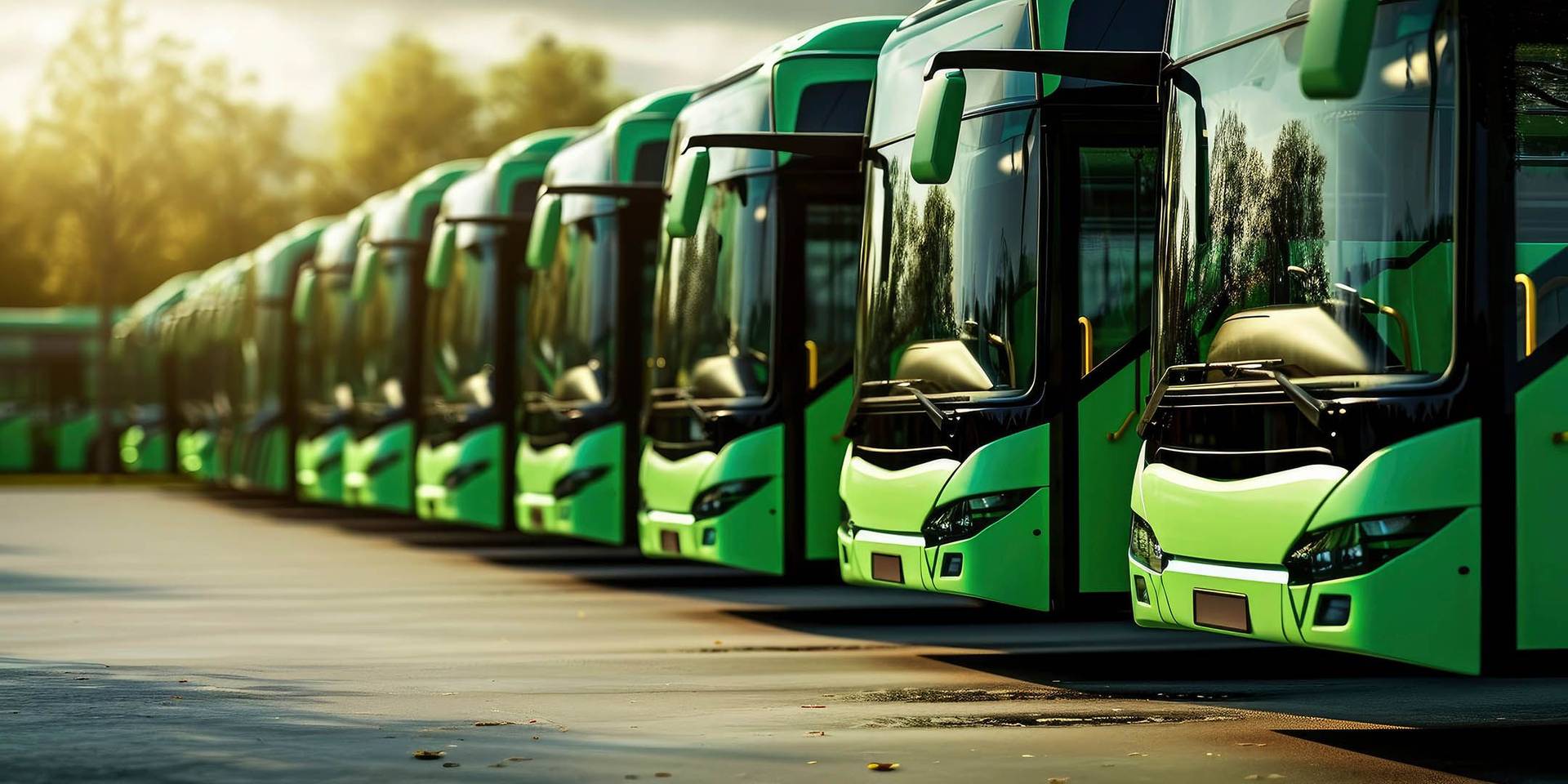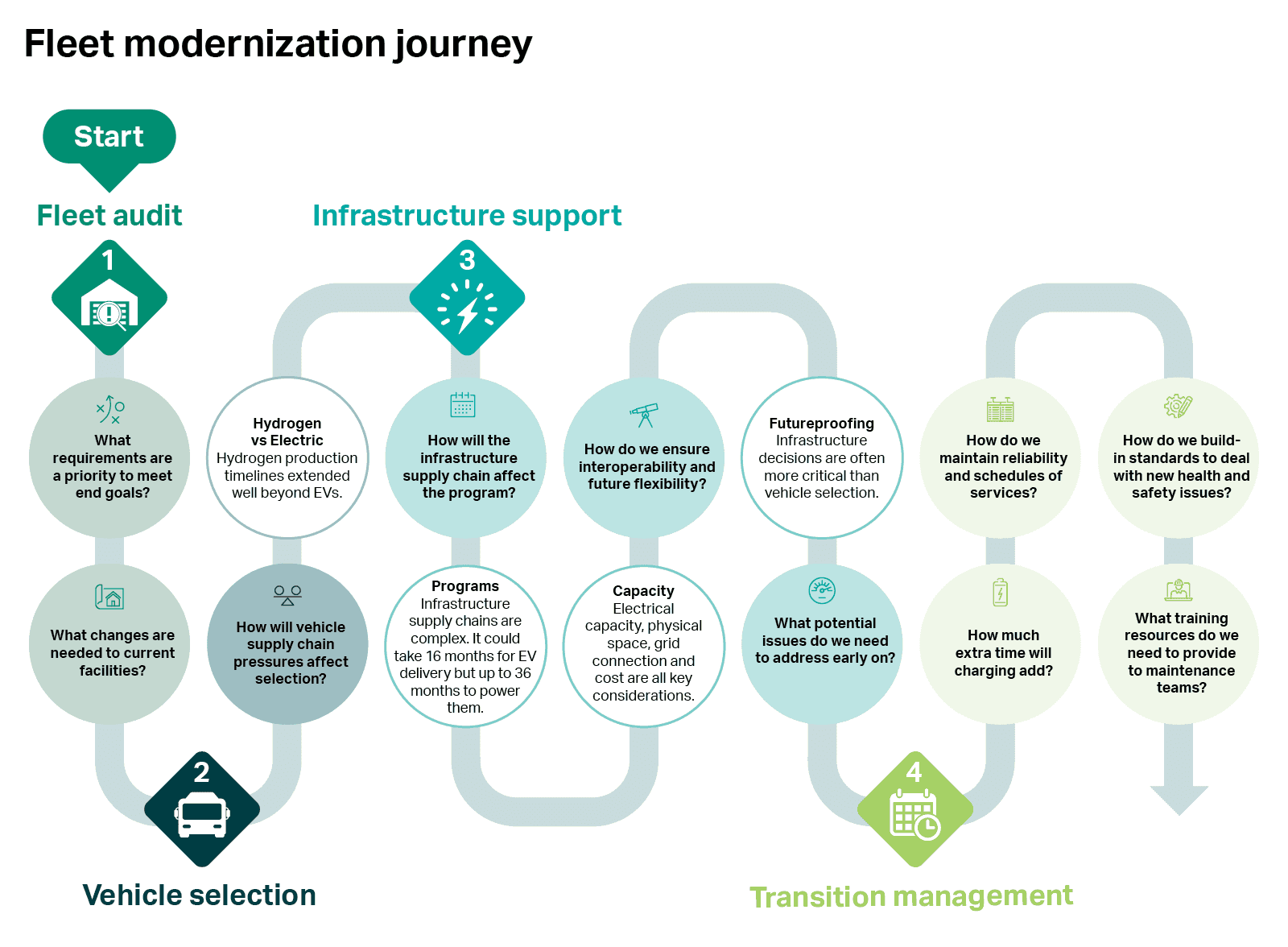
Navigating the pathway to fleet decarbonization
If you run a fleet of any size, you’re likely making strides to reduce reliance on fossil fuels. In principle this seems straightforward: simply transition to more sustainable vehicles. But as Andrew Bui, our global bus and zero emissions lead shares, the reality is more nuanced. There are several operations and infrastructure implications that need to be carefully considered before that first vehicle can take to the road.
Decarbonizing and modernizing today’s fleets — from garbage trucks and buses to police cars and delivery vehicles — is an essential undertaking on the route to net zero. It’s an opportunity to run vehicles fit for the modern world, incorporating powerful digital technology, offering increased efficiency, and contributing to healthier communities.
The United States (U.S.) is embracing this transition by putting federal policies and mandates in place. Many states are swinging into action independently, setting firm targets to encourage and speed change. Among them, California has committed to phasing out its bus fleets powered by internal combustion engines. New Jersey and several other states are introducing the same plans. On top of that, low- and zero-emission grants – some up to 80 percent for the purchase of low emission vehicles, infrastructure, design and management – are being offered to support projects that speed the transition.
Many organizations are tapping into the rewards of embracing net zero. The public health benefits are well documented, but there are also operational efficiencies to be gained, including a potentially significant reduction in fleet maintenance and fuel costs. And it’s not just the U.S. that’s stepping up – Brisbane, Australia, is looking to make the 2032 Olympics carbon-positive while Transport for London (TFL) in the United Kingdom (U.K.) is committing to a zero emission bus fleet by 2034.
A question of ‘when’ not ‘if’
There is genuine desire to make change. Some transport agencies and fleet managers are understandably nervous, though, about ensuring the transition is carried out safely and efficiently, with minimal operational disruption.
This starts by understanding what needs to change and how, using these four considerations as your guide:
1. Are you choosing the right vehicles? Review in detail what your vehicle requirements are and then search the market for vehicles that can do what you need. How quickly will they be available? You might be better off choosing hydrogen as a fuel rather than electric, for example. Range is always a top priority, so knowing how much energy will be needed to move the vehicle and its load is vital. Also, consider operation in different temperatures. This can dictate technology choice as battery electric vehicles, for example, have struggled in colder climates.
2. How will you connect to your fuel source? If you choose electric vehicles (EV) for a large fleet, you’ll need a substantial amount of power to charge the batteries. One transit agency had to increase their input from one to ten megawatt(s) to charge their fleet of 150 electric buses. Does your current grid supplier have enough capacity? What’s the cost of the energy and the infrastructure required? If you decide to run hydrogen vehicles, how and where will fuel be sourced and delivered?
3. What about the charging infrastructure? If you choose electric power, you’ll need to work out how to transfer it from the grid to your vehicles. Where do you put the charging terminals? Do you have enough space? Who’ll do the charging? If it carries additional responsibility, how will you manage your operations to account for this change?
4. Can you ensure health and safety? When you power a vehicle differently, you introduce new hazards. Do you have safeguards in place for this and other significant and potentially life-threatening issues? Managing or addressing fires from vehicles with batteries (as opposed to petrol) can be much more challenging and requires different approaches, mitigations, and safety requirements for both fleet owners and fire departments.
Our most recent Future of Infrastructure global research report —‘Lost in transition?’ revealed less than one-fifth of survey respondents reporting advanced stages of progress on their organization’s transportation decarbonization goals. Some early adopters who have pursued zero-emission fleets have already confronted the above challenges. Experienced partners who work alongside you as complex integrators can provide ‘proof of concept’, signposting the way toward fleet net zero. Like any major operational change, the move to a modern, zero-carbon fleet needs a detailed master plan.
A playbook for successful transition
Decarbonization provides an opportunity to redesign how fleet systems operate. But it’s only by focusing on key outcomes and benefits that we can arrive at a zero-emission strategy that truly meets a fleet’s needs. This is best served by an outcomes-focused program management approach that appreciates the ever-changing nature of the energy transition.
By having a view of all agencies, organizations and stakeholders involved in a fleet decarbonization effort, we’re able to respect that the transition is a process of transformation that’s different for every organization, depending on its unique mix of characteristics, knowledge and awareness. The key is to know where one stands on the energy transition continuum. You can find out more about this here, which provides a useful vantage point from which to order priorities and determine practical next steps based on your unique set of needs.

Laying the foundation for the future
Fleet decarbonization is a long-term endeavour. Having an established vision and your desired outcomes in place early on helps maintain focus. Especially as new technology becomes available or unforeseen challenges arise and your plan needs to be reappraised. Building a transit system that’s easier and more efficient to run and use will have a significant positive impact on people and our planet. With the latest digital tools and capabilities, a holistic approach to program management is essential to bring all the moving parts together and enable those outcomes to come to life.
For more on this topic, read our most recent Future of Infrastructure global research report.